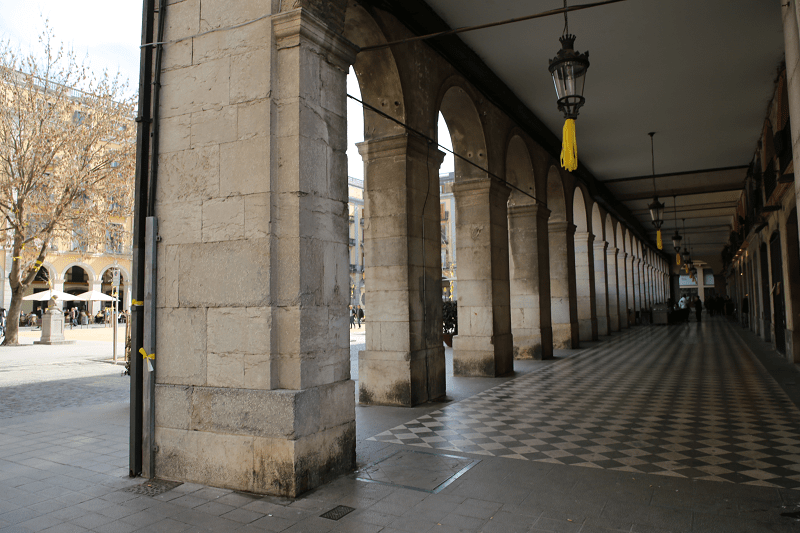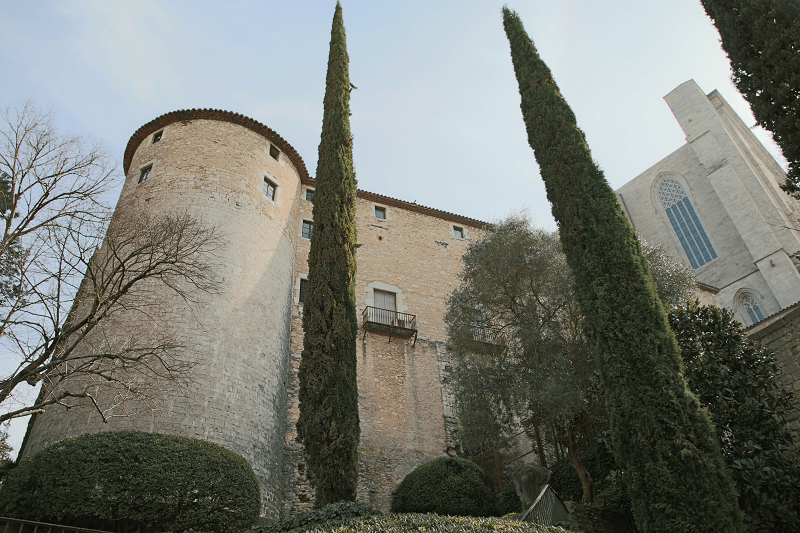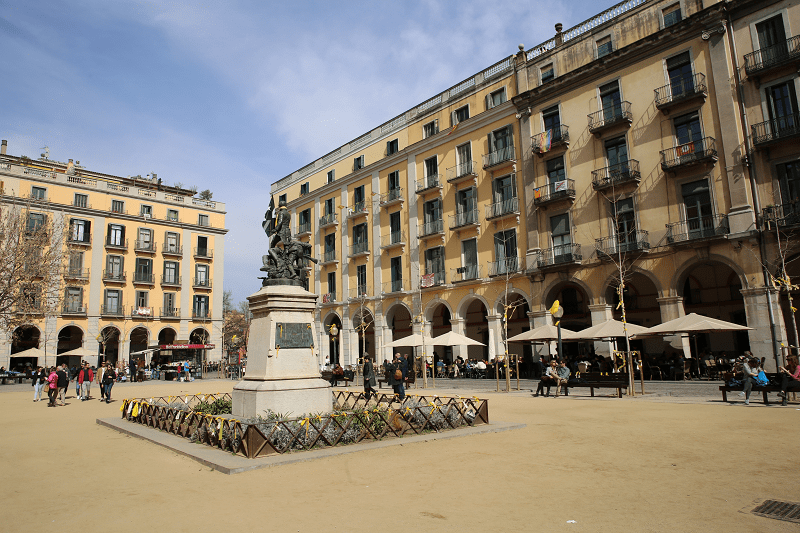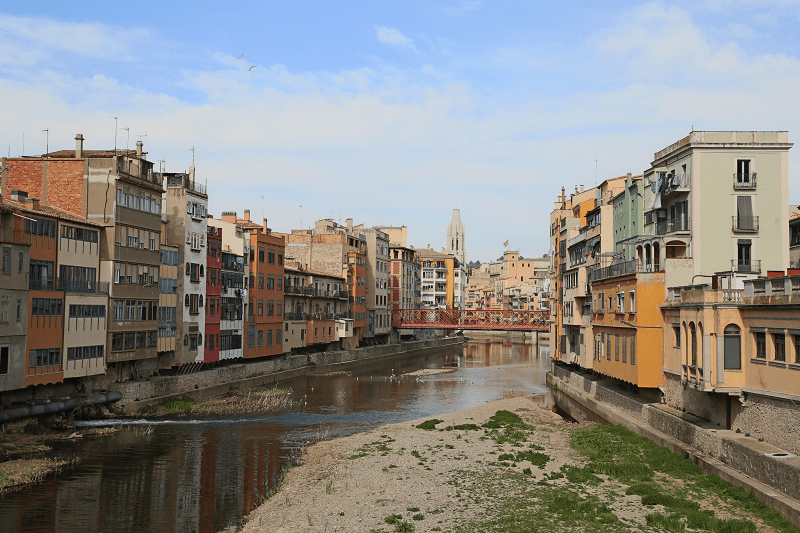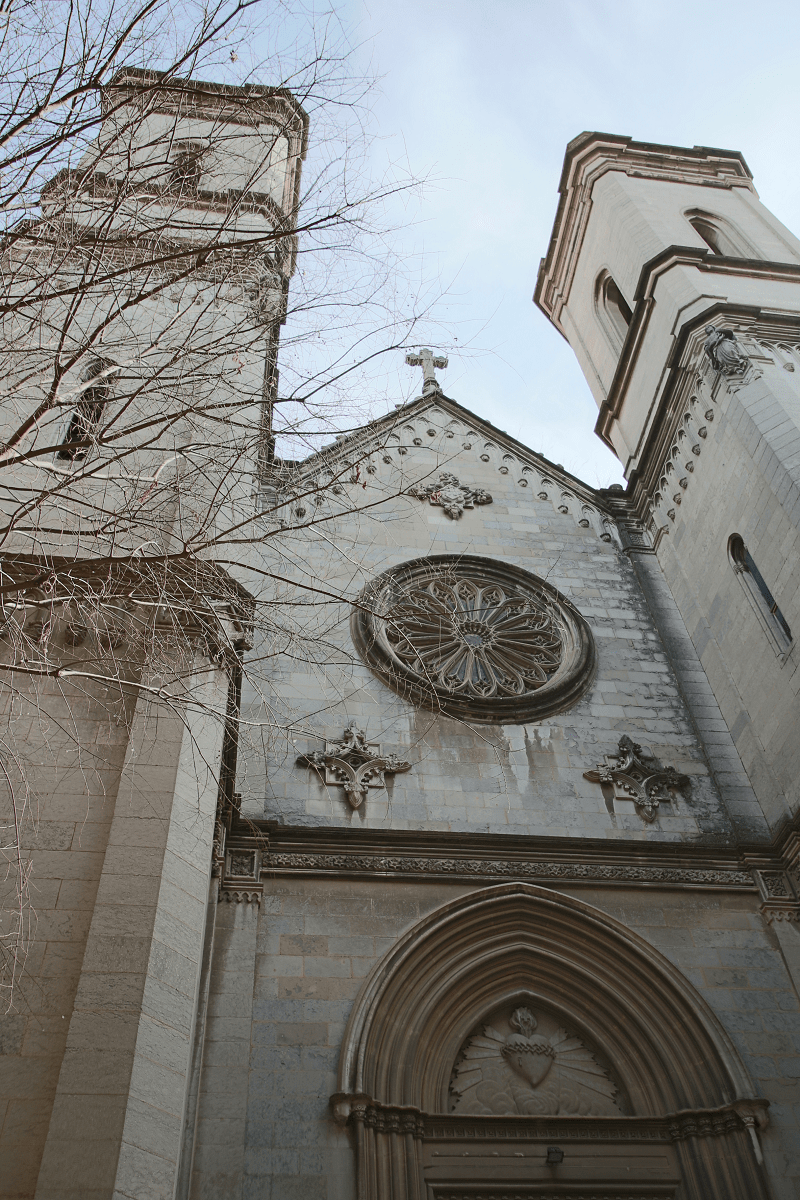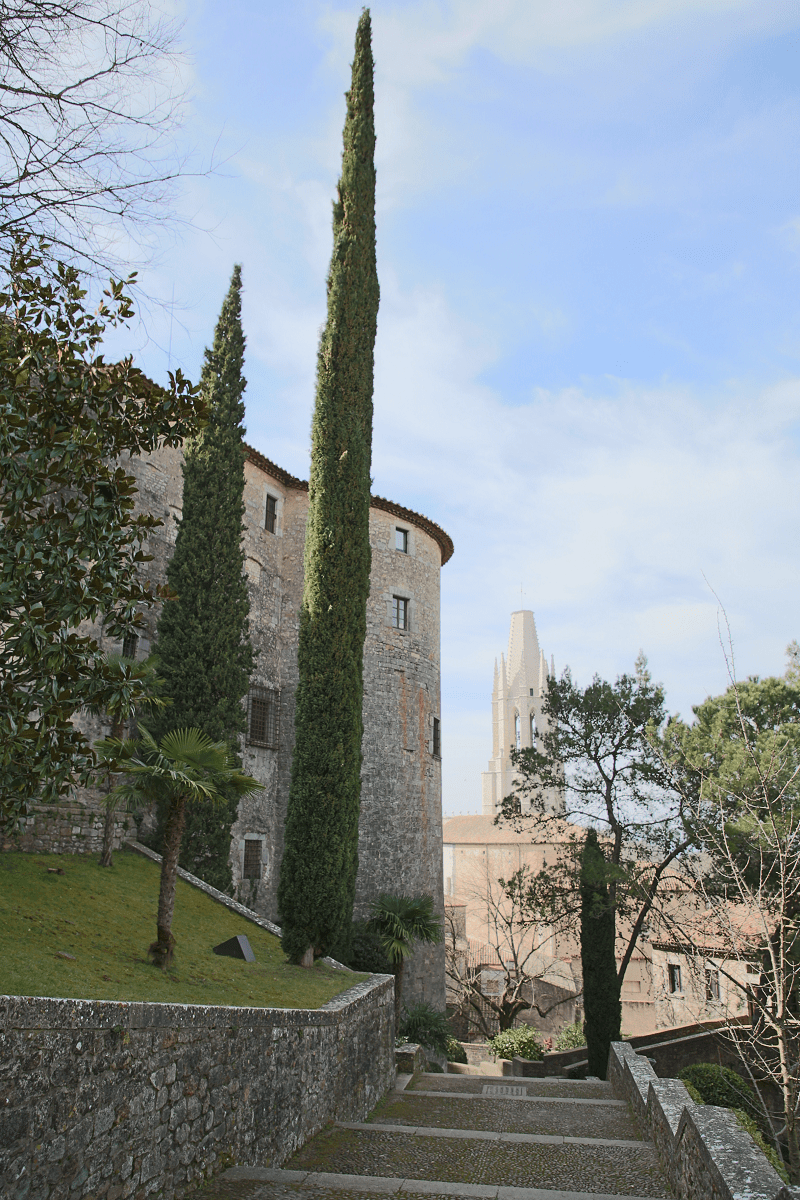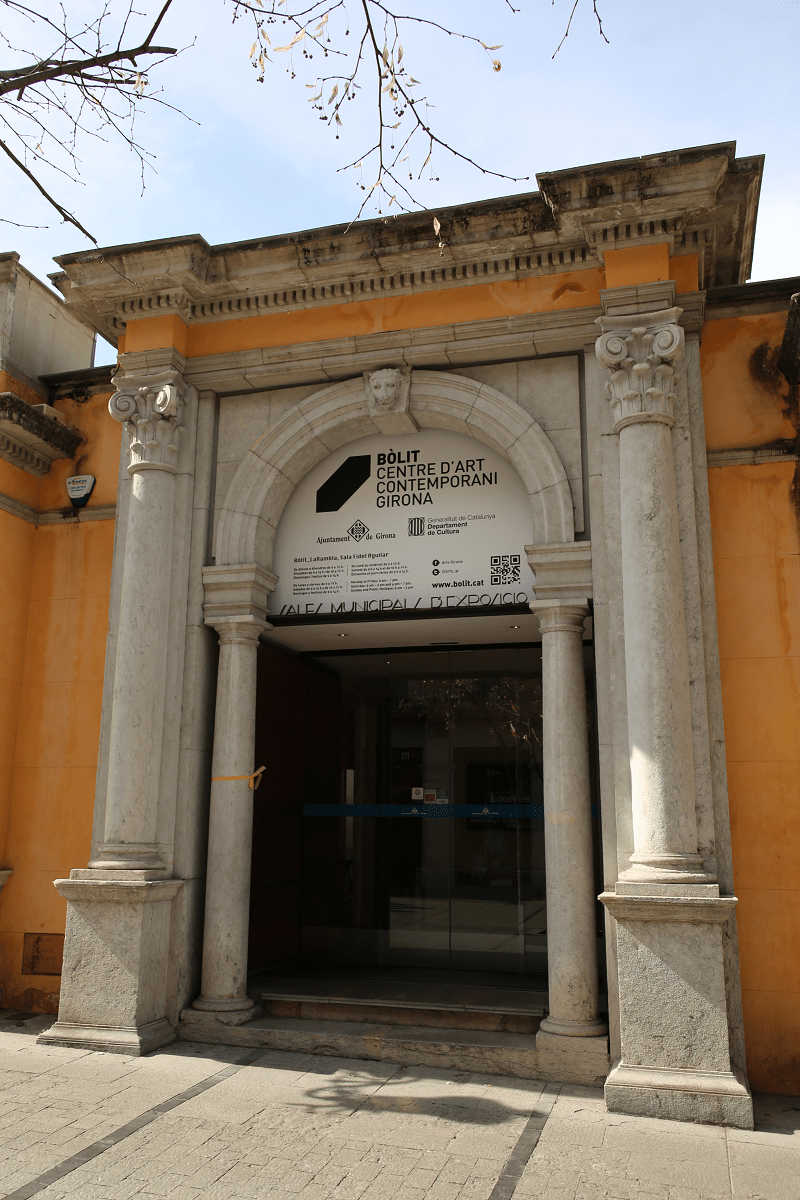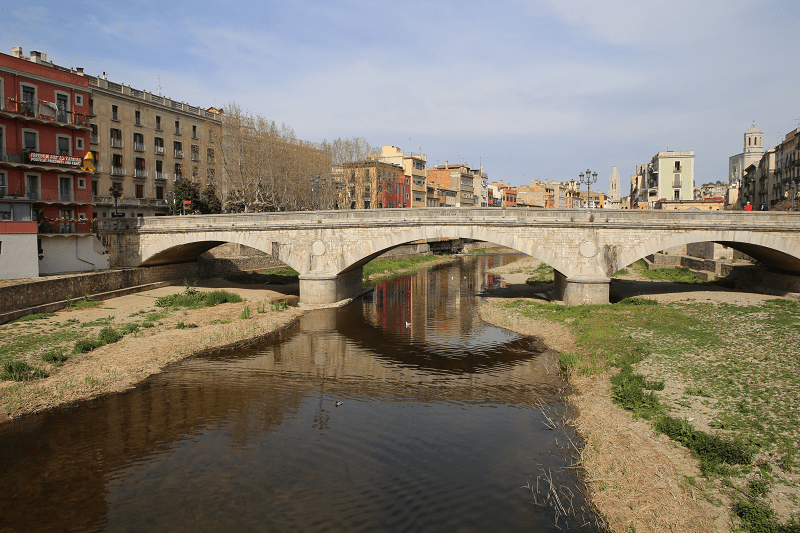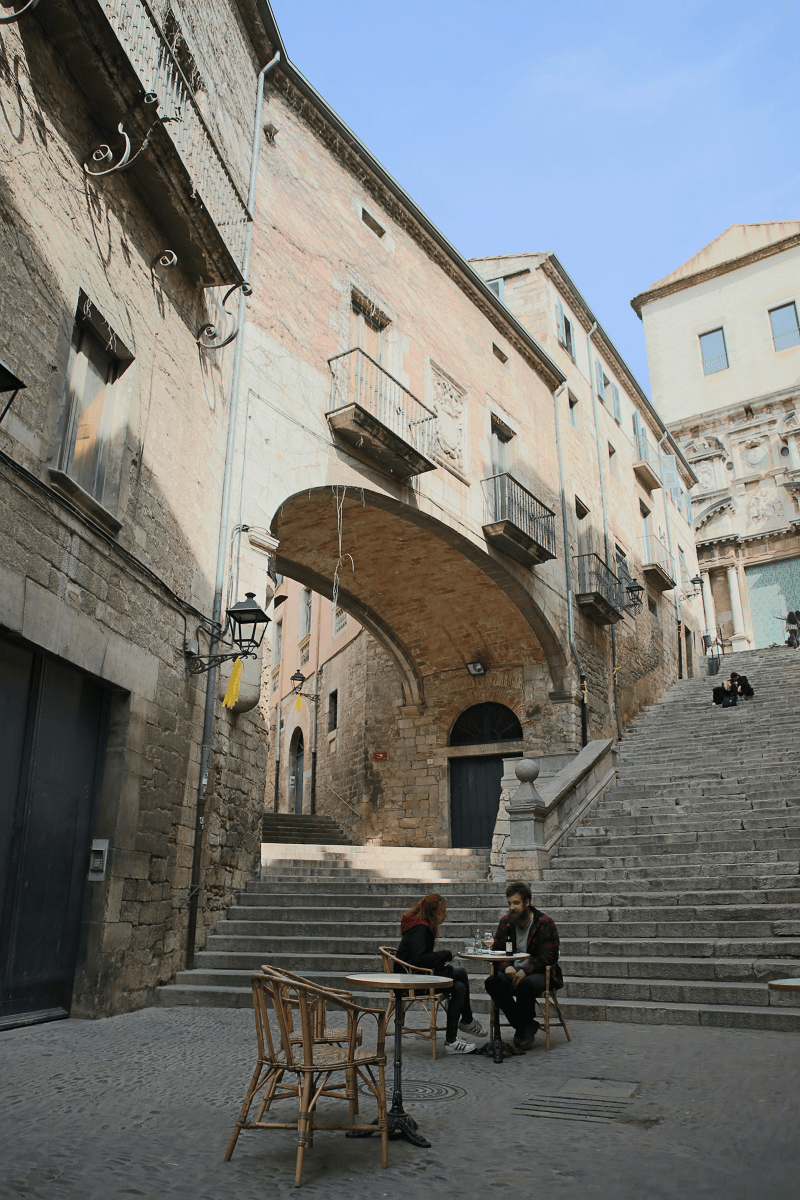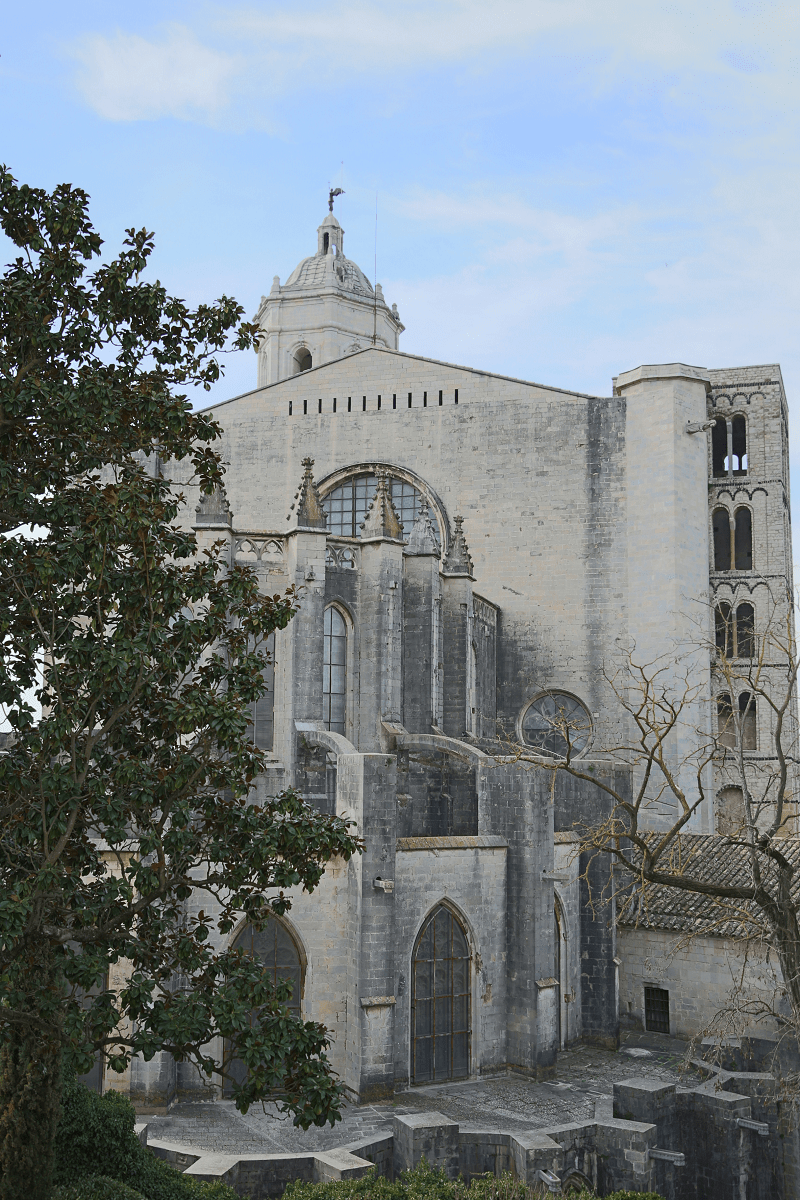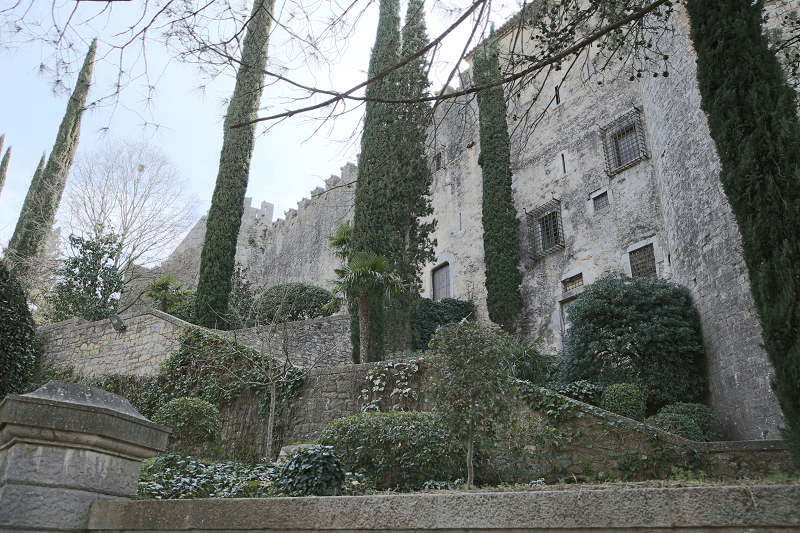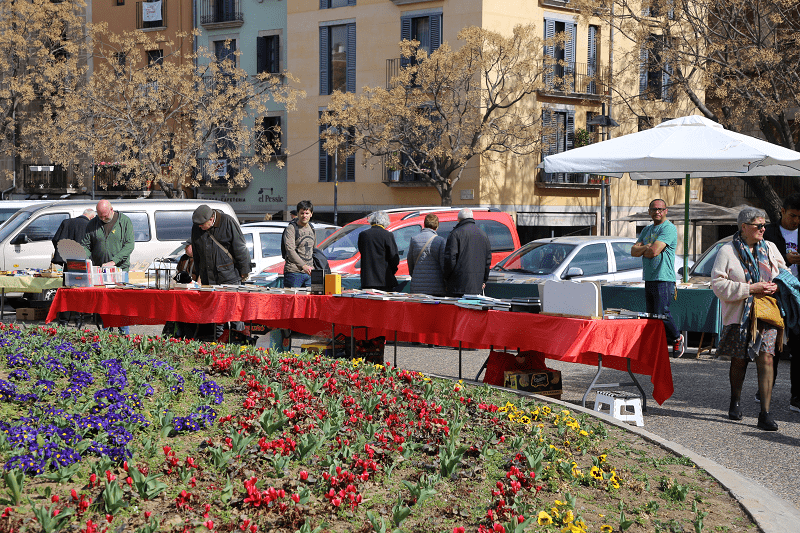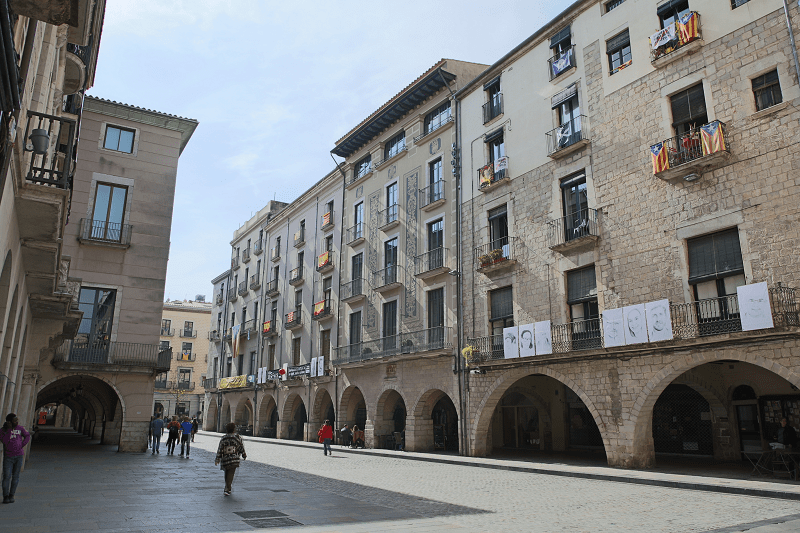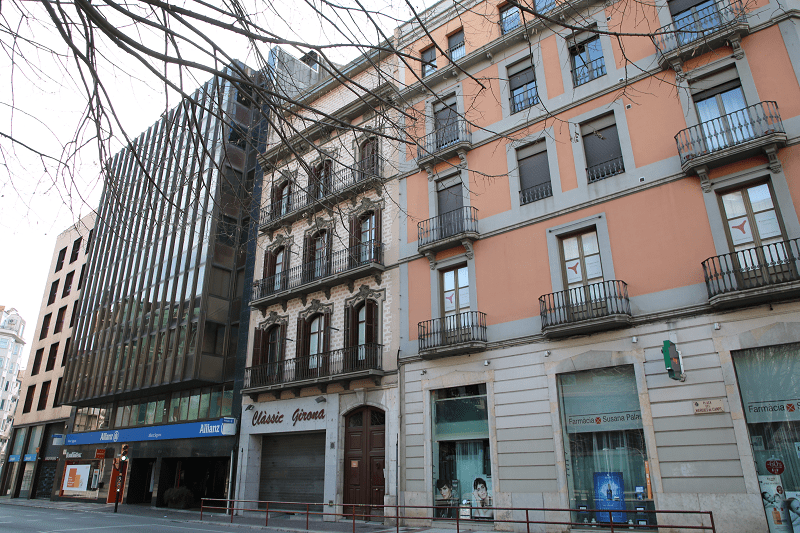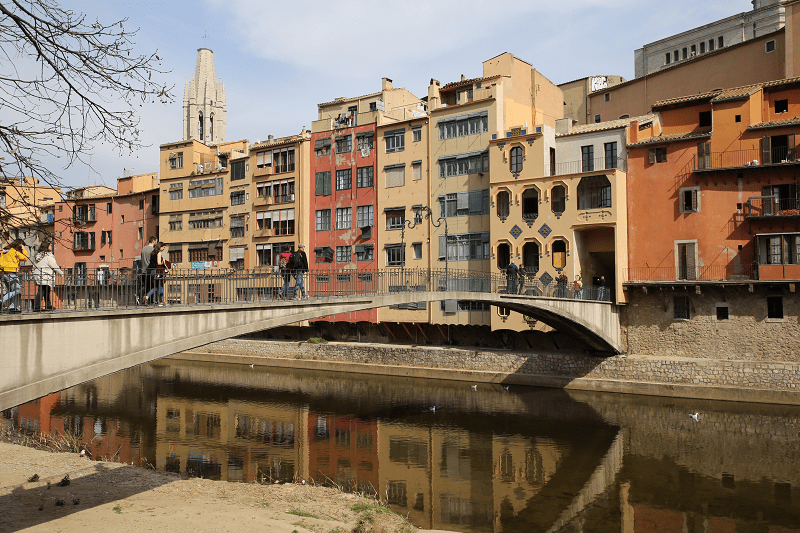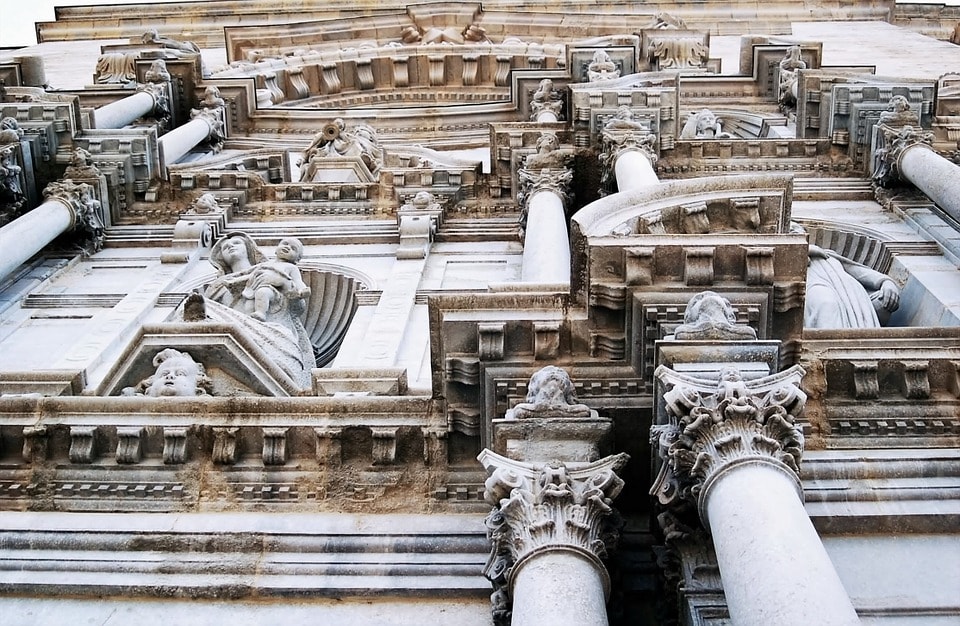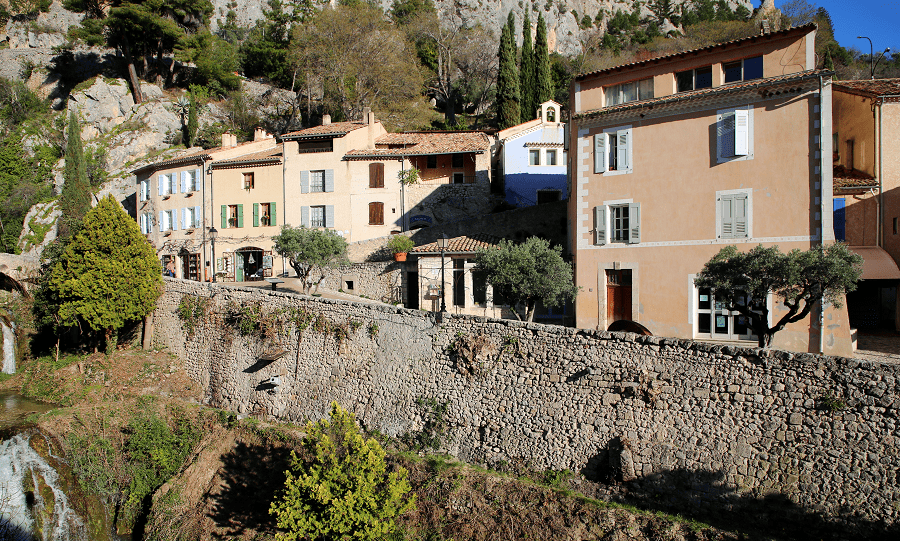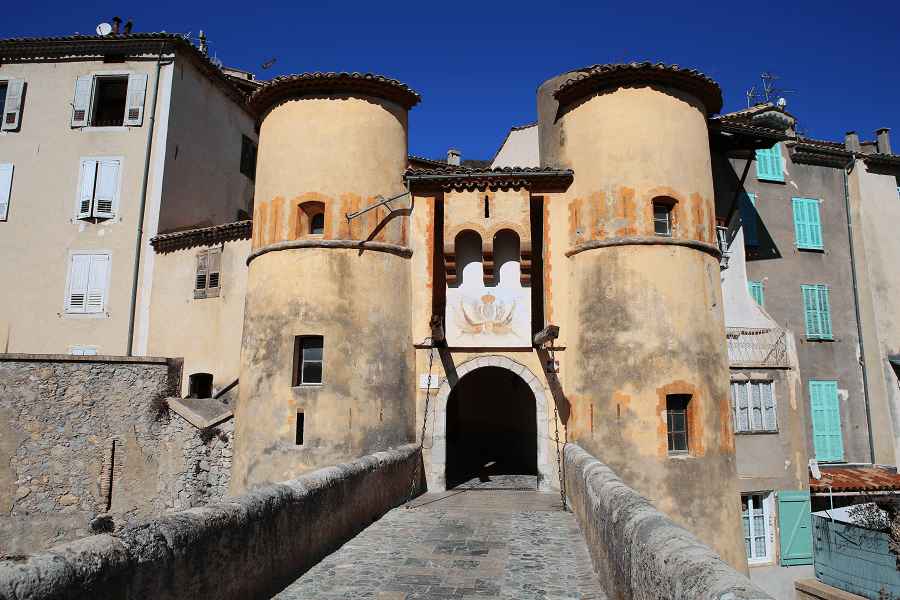Girona (cat. Girona) is a city and a municipality in Spain, northeastern Catalonia, its the capital of the comarca Gironès and the province of Girona. It belongs to the area of the Comarques Gironines.
The city lays at the confluence of four rivers: Ter, Onyar, Güell and Galligants, at an altitude of 75 m a. s. l. Its municipal boundary limits to the north with Sant Julià de Ramis and Sarrià de Ter, to the east with Celrà, to the southeast with Juià and Quart, to the southwest with Fornells de la Selva, Vilablareix and Salt, and to the west with Sant Gregori.
The first settlers were the Iberians of the Indigees tribe, located in the higher settlements that surround and enclose the Girona plain, such as the gorge of the current Sant Julià de Ramis, which was the most important. In the wake of the Sertori wars (82-72 BC), towards 77 BC, Pompey built an oppidum (fortified walled square) on Via Heraclea (future Via Augusta) to defend it and fight against the sedentary Sertori, the faction of the Populares, who had risen armed with the Roman Hispania against Sulalla of the faction of the Optimates who controlled the power in Rome. It is then, for these military needs, that the Roman occupants founded the original Girona, which was called at that time Gerunda, whose etymology has not yet been clarified, although it could mean “between the Undarius”, name of the current river Onyar in the Iberian language. See here more history
Its Old Town or Barri Vell is one of the most evocative in Europe, and has some monumental elements that are unique on the continent. It is delimited by the so-called Passeig de la Muralla, the round walkway on the old Carolingian walls from 9th century and the Late Middle Ages (14th and 15th centuries). Among its monuments are the Call (former Jewish quarter, the best preserved in Spain), as well as the famous and colorful Cases de l’Onyar (houses on the river Onyar), and above all there is the Cathedral, with a very unique large nave, which is the widest in the world in a Gothic style.
Tourism and main places of interest
● The Girona Cathedral
The catholic christian church of Saint Maria de Girona is the cathedral headquarter of the Bishopric of Girona and the largest Christian temple of the bishopric and homonymous province. The bishops of the diocese of Girona were documented generically in 516. According to some documents from the 7th century, their worship was comparable to the dioceses of Toledo and Seville. During the Muslim occupation between the years 715 and 785 it was transformed into a mosque. Its most particular feature is that it has the largest gothic nave in the world, of 22.98 meters, which is at the same time the largest nave of any style except for the St. Peter’s basilica in Vatican, which is twenty-five meters. Strategically located in the central part of the old city, known as the “Força Vella”. It coincides with the urban layout of antic Gerunda, the Roman settlement of which there are still remains of the walls in the current square of the cathedral.
● The church of Sant Feliu de Girona
The church Sant Feliu, o Sant Fèlix, is a basilica collegiate of Girona, originally from the early days of Christianity. It houses the offices of the Parish of Sant Feliu of the Diocese of Girona, so called because it was the main church of Girona before the construction of the cathedral. Its construction, in honor of the Sant Feliu martyr, extended from the 12th to the 17th century. It retains much of the Romanesque construction, later completed with the Gothic naves and roof and the baroque façade. The main attraction are the eight extraordinary Roman and Paleochristian sarcophagus from the 3rd and 4th centuries, found during the construction of the church, along with the Gothic tomb of Sant Narcís.
● The monastery of Sant Pere de Galligants
The old Benedictine abbey of Sant Pere de Galligants is one of the most important Romanesque sites surviving in the city of Girona. The construction started in 992, the current nave dates from 1130, as does the Lombard-style octagonal bell tower. The cloister ranges from 1154 to 1190 and also has a Romanesque style. At present, it houses the Girona section of the Archeology Museum of Catalonia.
● The Call – the Jewish quarter
The Jewish Quarter of Girona is one of the most emblematic along with that of Besalú. Also known as the “Call jueu”, the neighborhood conserves the original layout of some streets, such as c/ Cundaro and c/ de Sant Llorenç. Its crossing of medieval alleys allows us to get to know the history of Judaism in Spain.
● The Arab Baths
The oldest date in which the existence of baths is documented is December 18, 1194. The document states that the baths of Girona have been built by the order of the king Alfonso II the Chaste, they were property of the monarch, and that it was a new construction, without implying that it was a rebuild of previous construction or transformation. The building has a Romanesque style, but the monument doesn’t hide the Arab influences inherited from the Greco-Roman thermal tradition that affected the architectural elements and the functional structure of the baths. It was with the conquest of Lleida and Tortosa that this system of baths was discovered, and imported into Girona.
At the end of the 13th century, the attacks by the armies of King of France, Philip III, damaged the baths building, to the point that it needed an almost total reconstruction. King James II agreed to Raimon de Taialà’s proposal, which reconstructed the building between March 24, 1294 and December 4, 1296. It is documented that until 1366 the baths were public. However, from that date until 1416 there is an absence of historical references on the site. In 1416 there are news again, but they talk about baths that are no longer public. The documentary references mentions a house, with its garden and integrated baths. Between the 15th and 16th centuries, it seems that they were part of a private property.
In the 17th century the monastery of Capuchin was built, which meant that the baths were incorporated to it. Much of the architectural complex of the area, including the baths, was affected by a rigorous closure, which also changed the character of the entire area. The nuns kept parts for their own use. For example, the old pool was used as a laundry room. The years 1929-1930 saw the segregation of the baths, after being almost forgotten inside the cloistered monastery. On March 8, 1929, an agreement was established whereby the Arab Baths were disassociated from the whole monastic building. The agreement was signed by the president of the Diputació and the abbot of the Capuchin. Since the date of the construction of the baths, their surroundings have experienced remarkable changes. If they were originally built on the outskirts of the city, they are now surrounded by an urbanized and inhabited area.
In the 1960s, the Archaeological promenade was opened, which gave way to a wider street, a better neighborhood and a better character in general. Once separated from the cloister, with the relevant works carried out, the so-called Arab Baths could be visited, studied and admired, and incorporated into the archaeological site that Girona offers its visitors. From 1931 until 1939 they were under the responsibility of the Delegate Commissioner of the Generalitat; from 1939 to 1992, under the care of the Diputació and now they are entrusted to the Consell Comarcal del Gironès.
● The Barri Vell
Known as Barri Vell (the old quarter) is the part of the city that is, or was, bordered by the medieval walls and the bastions of modern times. It is Girona before 1895, prior to the demolition of the walls of the Pla de Girona. Inside, there are the main monuments of Girona and the original and primitive centre of the city. This neighborhood was subject to a profound renovation as of 1982 by the city council, it underwent a rehabilitation and restoration, with a focus on tourism. After almost two decades, the Barri Vell is the main tourist attraction in the city, with a large part of buildings rehabilitated and restored centre, especially the jewish Call.
● The walls
The Passeig de la Muralla (city walls promenade) is a part of the round walkway that goes through the old Carolingian walls (built in the 9th century) and the Late Middle Age walls (built between the 14th and 15th centuries) that surround the Historic Center of the city.
● Les cases de l’Onyar
The characteristic houses of the old quarter hanging over the river Onyar on its way through the city. All of them have the river façades painted following a chromatic palette set by Enric Ansesa, Jaume Faixò and the architects J. Fuses and J. Viader.
● Masó House
Casa Masó is the birthplace of Rafael Masó (1880-1935), and one of the most important works of his architecture. It is also the only house of the famous river houses of Girona that is open to the public. The house is preserved with the furniture and decoration of the noucentisme (Catalan cultural movement of the early 20th century), and also offers unprecedented views of the city. The current Masó House is the result of the successive union of four houses acquired by the family since the middle of the 19th century and the beginning of the 20th century, its current appearance is similar to that it had after the last intervention by Rafael Masó, in 1919. From 2006 the house is owned by the City Council of Girona and is managed by the Rafael Masó Foundation.
● La Farinera Teixidor
The building of the Farinera Teixidor (1910-1911), the work of the Girona’s noucentisme architect Rafael Masó i Valentí. Commonly known as the “Casa de la Punxa”, in reference to the most outstanding element of the building. The chamfer tower was conceived as a block of rental apartments that was part of a group of naves and buildings of Farinera Teixidor. The tower, with its glazed ceramic flake roof, is a modernist reminiscence, a style surpassed by the rest of the construction, which is characterized by the formal simplification of the façade. The acquisition as private property by the Collegi d’Aparelladors (Association of Surveyors), in 1979, lead to the restoration of the building.
● The Devesa Parc
The Devesa Parc of Girona, with an area of almost 40 hectares, is the largest urban green space in the city of Girona and one of the largest in Catalonia. It is framed by the river Ter in the north, the Güell in the west, the Onyar in the east and the Güell-Devesa district in the south. Most of the park is populated by a monospecific set of about 2,605 Platanus trees, although there are also: open and sunny spaces, sport fields, gravel esplanades, an irrigation system with permanent water, urban gardens, cultural facilities of the city and public use buildings, such as the Fira de Girona and the Auditori-Palau de Congressos.
A very important fact is that the Devesa trees were planted during the 1950’s, and in some cases they reach 55 meters. The trees of the Devesa give the parc a unique character, to the point of turning the Park not only into a reference for the city, but also a Cultural Asset of National Interest (classified as such according to the Decree of September 27, 1943). Especially thanks to the Platanus trees that create an orthogonal structure and give monumentality to the Park.
● Rambla de la Llibertat
Rambla de la Llibertat is the old backbone of medieval, baroque and nineteenth-century Girona, it is the busiest and most emblematic public space in Girona. However, the existence of La Rambla is quite new, since its configuration dates back to 1885 when the city architect Martí Sureda unified the Cols square with the Abeuradors street and demolished the esparto arches. All of the space was then converted into a tree-lined walkway with linden trees and benches that became known as Rambla de la Llibertat, in honor of the Liberty tree planted in 1869 during the democratic period. Although the space was very influenced by Sureda, it preserved a part of the medieval portals and some other palaces of the same period. However, the construction of nineteenth-century buildings was quite high and it transformed the medieval character to some extent. Currently the Rambla is the axis of entrance to the Barri Vell for the tourists who arrive in the city as well as a common place to stroll for gironians, who maintain the customs of buying flowers at the floristeries (cat. flower shops), that every Saturday set up their stands on the street, or “have a vermouth” in one of the cafes on the Rambla.
● Plaça de la Independencia or of San Agustín
Central sculpture of the plaça de la Independència. The plaça de la Independència (cat. Square of Independence), which name refers to the war of independence of Spain (see Peninsular War) and not to a hypothetical independence of Catalonia, is one of the most popular and frequented squares in Girona. Located in the Mercadal neighborhood, in the center of the city, the square stands where there used to be the convent of San Agustín. Which is why this square is also known as the Plaza de San Agustín. The attractiveness of this square lies in its nineteenth-century style: the entire space is surrounded by austere and identical neoclassical buildings, with little porches on the ground floors, in a style similar to that of the Royal Square of Barcelona. In the center of the square there is one of the few nineteenth-century sculptural groups dedicated to the defenders of the city of Girona during the sieges of 1808 and 1809.
However, this square of symmetrical proportions corresponds more to present times interventions, rather than the inheritance of the aforementioned architectural actions. The municipal architect of Girona Martí Sureda was the first who designed a closed square with porches and neoclassical vaults as well as buildings that kept the same proportions and aesthetics. However, the urbanization of the area only partially followed its schematics and the construction of the city’s first cinemas crashed this idea. It was not until the 1980s that it became possible to complete the idea imagined by Martí Sureda in 1855. Therefore, this place of noucentista and romantic style is a timeless creation, from one century to another, that today captivates inhabitants and visitors of Girona. It is a place full of life thanks to the ongoing addition of cafes and restaurants. Within this square there are historical businesses, such as the Café Royal, the Albéniz Cinema and the Casa Marieta.
● The bridges on the Onyar river
One of the main problems throughout the history of the city has been the union of the two parts separated by the river Onyar: the right bank (Barri Vell) and the left bank (barri Mercadal). That is why bridges have played an important role in the development of the city. At the moment no bridges remain from the medieval times and the majority of the constructions are contemporary. Among them, stand out four bridges: the stone one, the iron one, the bridge of Gómez and the railway viaduct.
The stone bridge (or Isabel Segona bridge) dates from 1856, and replaced the medieval bridge of San Francisco (located next to the now gone convent of the Franciscan friars), which linked the two neighborhoods of the city. The Stone Bridge is very representative of the city, it was built with blocks of the typical Girona stone, containing abundant fossils of nummulites.
The iron bridge (or bridge of old fishmongers, or Eiffel bridge, in honor of Gustave Eiffel, whose company built the bridge) was opened in 1877, according to the commemorative plaque of ceramics. It replaced the old wooden paths built by some carpenter.
Gómez’s bridge (which takes its name from the person whose house was partly expropriated to build the bridge) dates from 1916, and is made of reinforced concrete. It breaks the style of the previous bridges with a sleek, modern, and austere structure. It was designed in 1914, when the reinforced concrete was the latest constructive innovation.
The fourth bridge is the railway viaduct, built in 1876, representing the arrival of modernity and progress into Girona, that was still walled at the time.
● The castles
Castell de Sant Miquel
The castle of Sant Miquel is an architectural complex on the top of the hill or mountain of Sant Miquel, between the municipalities of Girona and Celrà (Gironès). Its situation at the summit allows for control over a large territory. This complex surrounded by a moat has a hermitage, called Sant Miquel Arcàngel, and a square base tower. The site is a perfect example of the successive reuse of this space over time, depending on the changing needs. At the moment, the space has been reformed by the City Council of Girona, paths have been adapted, and routes have been created to reach it easily, as it has become a regular place for cyclists, runners, and families.
Castell de Montjuïc
Montjuïc Castle was a bastion built in Girona on the Montjuïc mountain at the order of Philip IV in 1653 to ensure the security of the accesses to the Pla de Girona from the north, together with four defense towers: Sant Joan, Sant Daniel, Sant Narcís and Sant Lluís. The general floor plan of the castle was square, with an enclosure constructed with four bastions connected with walls of 150 meters in average length. It was very useful in the so-called War of the French, especially in the three sieges of the city (first siege of Girona of 1808, second siege of Girona of 1808 and siege of Girona of 1809) until finally it was abandoned on June 11, 1811, being unused in 1814, at the end of the war, by order of Marshal Louis Gabriel Suchet, after building the Suchet tower in 1812. In 1843, a bombing of General Prim destroyed it. It is at the highest point on the mountain of Montjuïc, at 219 meters above sea level. Joan Francesc Molinas and Sicart and Álvarez de Castro were some of its governors. At the moment, the City Council of Girona is preparing a plan to rehabilitate the castle in order to recover its public and tourist interest.
Tower of Alfonso XII
The Tower of Alfonso XII is a large watchtower of 160 meters that unfolds a magnificent panoramic view of the whole city, from south to north, with the Devesa, and further to the Pyrenees, with Canigó and Puig Neulós as a backdrop, following the circular path around the tower. It was built in the nineteenth century in the same place where previously stood the stronghold of the City, also called Sant Narcís or Estudiants, built in 1675 as an outstanding part of the fort of Condestable within the defensive system of the east and southeast of Girona. This fort of Condestable was connected with two others, following the highest points of neighboring hills: the one of Reina Anna and the one of Capuchins.
The stronghold was blown up by the French in 1814, after the Peninsular War, like the rest of the neighboring fortresses. During the Third Carlist War (1872-1876), the interior and the stones were used to build the so-called Tower of Alfonso XII, a small fort built in accordance with the defensive guidelines of the end of the 19th century . Below the tower, we find the Mirador fountain, an ideal stop point to rest and contemplate the Old Town and the emblematic monuments of the city, from an unusual perspective, under the shade of a nettle tree.
Culture and traditions
● Festes de Sant Narcís or Fairs of Girona
The Girona Fairs are celebrated during the week of October 29, the day dedicated to Sant Narcís, patron saint of the city. The holidays usually begin with a parade and a mass performed from the balcony of the town hall. The day of Sant Narcís celebrates a solemn mass dedicated to the saint in the church of Sant Feliu de Girona, where there is the chapel of the saint with the supposed remains of his relics. There is also the diada castellera de Sant Narcís, the most outstanding in the city.
The most entertaining section is in La Devesa Park, that hosts variety of attractions for children and adults, as well as the so-called “Barraques” fairs on the La Copa esplanade, where the most important musical concerts are performed. Since 2013, the musical spaces have multiplied, with performances in the square of Sant Feliu, the Miquel de Palol Square, the Auditorium of Girona, Plaça Calvet i Rubalcaba and Plaça del Vi. The celebration lasts until the Sunday following Sant Narcís, (in 2015 it was November 1) and closes with a spectacular fireworks display, which, from 2013, will be given by the winner of the International Fireworks Contest of Blanes. Throughout the time, the Sant Narcís celebrations have become a festival that includes all the municipalities of the comarques baixes of the Province of Girona, losing its more urban and traditional character, to exploit it in the most playful ways.
● Girona, Temps de Flors
This floral festival began in 1955 as a simple flowers exhibition in the church of Sant Domènec of Girona, organized by the Feminine Section of the FET and the JONS. Throughout the years the show was evolving, until it became a sample of floral creations in the mentioned church. In the 1990s, the city council decided to convert this isolated exhibition into an event that included the whole city. The monuments of the city were adorned and the owners of private patios in the Old Quarter were convinced to open them to visitors during the exhibition.
Thus, the current Girona, Temps de Flors, was born, and it ceased being a small flower exhibition to become the most important event in the city, bringing more than 200,000 visitors in the 2015 edition and promoting the Collaboration and expansion at national and international levels in cities such as Madrid, Salisbury, Gent or Perpignan. The floral exhibition, moreover, has gone from being a purely floral event and is already considered a festival, with a multitude of cultural events throughout the city, such as the A Cappella Music Festival or the European Opera Day. In 2015, the festival celebrated its 60th edition, with 168 floral projects distributed in 134 locations of the city. The communication campaign has recently been awarded by ESIC with the Aster Business Communication Award 2015.
● The Holy Week
The Holy Week (Setmana Santa) is the group of celebrations that take place between Friday before Palm Sunday and Easter Sunday. Through this vast and rich set of festive practices, theatrical staging and other liturgical and ritual activities, the Christian community remembers and recreates the last moments of Jesus Christ on Earth, known as the Passion, Death and Resurrection. Easter falls on different dates every year and oscillates between the months of March and April, since the date of Easter is fixed from the first full moon of spring. On Good Friday, in the midst of absolute silence, the processions that represent the last moments of the life of Jesus procered. In Girona, the Procession of the Holy Burial takes place and the Manaies of Girona as well as the Junta de Confraries de Girona participate in it.
Easter Gastronomy. In the past, the Church had imposed the practice of strict fasting and abstinence among its faithful. The use of certain products (“all meat products”) was prohibited especially in the period between Carnival and Easter. This promoted the creation of dishes cooked exclusively with authorized products — one of them was cod. This white fish, recognized for its caloric and nutritional qualities, is a good substitute for meat and has become a symbol of the Lenten period. Another typical Lenten product are bunyols. The bunyols of Lenten are traditionally made on Wednesdays and Fridays throughout the Lenten period, they are sweet, fried dough ball, with no hole in the middle, quite fluffy and served as dessert. The Mona de Pasqua is a cake that the godfathers give their children on Easter Monday.
This tradition comes from the celebration of the end of Lent and its fasting and abstinence on that day, and the most symbolic way to do it was by giving away a cake to the baby (it turns out that the word Mona comes from the Arabic word munna, which means gift). The Mona had to have as many eggs as the age of the child. Traditionally, the Monas eggs were not chocolate, they were simply hard boiled eggs on top of the cake. Along with the Mona de Pasqua, the Rams Tortell is available in every pastry shop during Easter. The Tortell de Rams is eaten on Palm Sunday, after mass. Tortell has many variations, depending on the pastry, but always with a hole in the middle and made of bread dough.
● City of Festivals
In 2013, the City Council of Girona created the brand ‘Girona, City of Festivals’ (Girona, Ciutat de Festivals), a guide with the main festivals of the city throughout the year. This embryonic idea, born to provide the city with a stable and transversal program throughout the year, has finally led to a renowned, famous brand throughout the country, that is synonymous with some of the best festivals of Catalonia. Currently, the brand is made up of 22 festivals: The Pepe Sales Festival, Ibercamera, Black Music Festival, MOT.
Festival of Literature, Festival Strenes, Festival In-Somni, A Cappella Festival, Temps de Flors, Inund’Art, Festivalot, Milestone Project, Ludivers Festival of the Cultures of the Imagination, Nits de Clàssica, Undàrius. Festival of Popular and Traditional Culture, Tempo sota les Estrelles, International Mapping Festival of Girona, Festival Internacional de Teatre Amateur de Girona (Fitag), Jazz Festival, Cinema Festival of Girona, Fairs of Sant Narcís (ARC Prize for Best Festival Program 2014), ‘Acocollona’t’ Fantasy and Terror Film Week and Temporada Alta. The brand ‘Ciutat de Festivals’ has also led to the birth of new stages in the city, such as Plaça Calvet i Rubalcaba, or unique shows during Girona 10, Temps de Flors, Sant Jordi, the Girona Fairs or events such as the return of the Sopa de Cabra musical group with a show from the roof of the Municipal Tourism Office. In addition, since 2014, it is closely linked to the Club Girona Cultura, through which its members can enjoy unique shows.
● Girona, Musical District of Catalonia
In 2013, for the first time in history, a city that was not Barcelona hosted the Enderrock Awards Gala, in particular, the Municipal Theater of Girona. The Enderrock Prizes – Catalan Music Awards are awarded since the creation of the music magazine, twenty years ago, and they are presented at a gala that brings together public and music sector since 1999, when it was established at the Barcelona Bikini room. In 2013, coinciding with the fifteenth edition, the organization opted for territorial decentralization, moving the event to Girona, which also aims to be a musical capital, until at least 2016. The celebration of the Enderrock Awards evolved in 2015 with the creation of “Girona, Musical District”, a weekend, prior to the awards ceremony, with special concerts of the protagonists, open interviews, screening of documentaries, and other cultural activities closely linked with the brand “Ciutat de Festivals” and “Club Girona Cultura”.
● Girona 10
Under the name of “Girona 10”, the Association of Hospitality of Girona published in 2013 a project to attract visitors on the weekend of January 14 and 15. The offer included a night at one of the 1,000 places that offered thirty accommodations at only 10 euros. This was also the menu price of many restaurants in the city that joined the initiative, which was completed with discounts in the shops and free tickets to cultural and museum establishments. From this first edition, which surpassed all expectations to the point of collapse, derived the concept of “Girona 10”, which no longer meant “10 euros”, but “top city”. This change was achieved with full collaboration of the public administrations, which changed the Girona 10 to become an event of the city with dozens of activities and concerts around the city throughout the weekend. The reformulation of the initiative in 2015 achieved a great success with all the places of hotels and restaurants booked, and the city full of visitors at a time traditionally known as very quiet and therefore usually empty. It was such a success, that the idea has already been copied in several towns of the region, also with success. The bookings of sites and menus must be done with a draw given the high demand.
● Cinema
Due to its urban and heritage characteristics, the city of Girona is widely used for advertising spots, photo shoots, television series and film footage. Among the feature movies filmed in Girona, stands out Soldiers of Salamina (2002), by David Trueba; The Monk (2010), by Dominik Moll; Perfume: The Story of a Murderer (2005), by Tom Tykwer; I Want You (2012), by Fernando González Molina; Dying Beyond Their Means (2013), by Isaki Lacuesta; Menu for two (2014), by Robert Bellsolà. The city also annually hosts dozens of shootings for all kinds of advertising spots and, in June 2015, it became known worldwide thanks to the shooting of much of the sixth season of Game of Thrones. On the other hand, the Girona Film Office annually organizes the SmartFilms Girona Contest, a free short film competition (filmed with mobile devices) and offers as a first prize of € 1,000, the largest prize in Spain for a contest of these characteristics.
● Llibre del Sindicat de Remença
El Llibre del Sindicat de Remença (The Book of the Remensa Union) of 1448 contains the acts of the meetings held by the remensa men, or serfs, of 912 parishes of the Catalan dioceses of Girona, Vic, Barcelona, Elna and Urgell in order to appoint their trustees or representatives who had to negotiate the abolition of the servitude of evil customs in front of the King Alfonso the Magnanimous. The remences meetings were held between October 13, 1448 and March 10, 1449, and brought together about 10,500 men. These assemblies, authorized by the king, also served to collect the necessary money to support the process.
In June 2013, the International Committee of the Memory of the World Programme meeting in Gwangju (Republic of Korea) agreed to register the Llibre del Sindicat Remença (1448) in the UNESCO Memory of the World Registry. It was the first Catalan document included in the record. Its inscription is based on the fact that the claims of the remences, which are evidenced by the Llibre del Sindicat Remença (1448), forced the servitude to be abolished officially in Europe in 1486 by means of the arbitration ruling of Guadalupe. With this action, the Girona document becomes the first and only one in Catalonia to be part of the world memory record. Spain has 4 works in this universal registry, which consists of just under 300 entries from around the world.
Museums
● Girona History Museum
Located in the heart of the Barri Vell, in the old Capuchin convent (18th century) and later provincial institute (1845-1968), the museum covers the whole history of the city of Girona from the first prehistoric settlers, passing through the medieval splendor until nowadays. In the museum you will find a route through the history of Girona, from the foundation in Roman times to contemporary times. It is a chronological journey through Roman, medieval, modern and contemporary Girona, that is completed with various areas dedicated to Catalan traditions, such as the Faràndula where you will find the local festivity images and the theme room “La cobla y la sardana. Música y danza en Girona” (cat. Sardana and cobla. Music and dance of Girona). It also has a theme room “Industrial Girona, a pioneer city”. The museum offers a varied program of activities, and temporary exhibitions are held within various spaces of the museum: the exhibition hall, the coal storage room, the cistern and the cellar.
The space of the museum is formed by the main building, the space dedicated to the Spanish Civil War and the air-raid shelter in the Jardí de la Infància (which are part of the Network of Democratic Memory Spaces). Also by another extension: the Agencia Gómez, an establishment of fine modernist design, which housed a notary archive, a bank office and a notary.
The building itself has witnessed a unique historical events, and it is a true marvel worth discovering. In the 15th century it was an important Gothic mansion owned by the Cartellà family. Later, around 1753, it became the convent of Sant Antoni, of Capuchin friars. It conserves, in magnificent state, amazing spaces of the old convent, such as the cemetery or desiccator, the cistern (interesting example of a water tank), the cloister and several impressive rooms. At the end of the 19th century it became the Institute of Middle School. Finally, since 1981, it houses the Girona History Museum.
● Museum of Archeology
The old church and the old convent of Sant Pere de Galligants houses the collections of the Girona section of the Archeology Museum of Catalonia, formerly the Provincial Museum of Antiquities and Fine Arts. Used as a warehouse for the archaeological excavations of Empúries since 1846, in 1857 the provincial museum was installed there, and in 1992 the project for the modernization of the facilities was carried out as a section of the Museum of Archeology of Catalonia. The museum houses all archaeological material of prehistoric and ancient times (Iberian, Greek and Roman) found in the province of Girona, that was not sent to the warehouses of Barcelona, as is the case of the statue of Asclepius of Empúries. In the collection you can find milestones, tombstones, mosaics and everyday use objects. The museum also houses finds from medieval era, such as epigraphy sets.
● Art Museum
Founded in 1976, the museum is located in the old episcopal palace of Girona, next to the cathedral. The museum houses art collections of all periods, from the Romanesque period to the contemporary era, with works by Ramon Martí Alsina or Joaquim Vayreda. The type of art pieces range from sacred art to decorative arts. The main collections is the medieval one, from which stands out the art from Empordà Monastery of Sant Pere de Rodes.
● Cathedral Treasury Museum
Museum dedicated to the relics and objects of value accumulated by the head of the Cathedral of Girona. It houses collections of sacred art, liturgical objects and goldsmith works. Among its pieces are the Beatus of Liébana, made in Zaragoza in 975, and the Tapestry of Creation, from the 11th or 12th century.
● Girona Museum of Cinema
Opened in 1998, it is a unique museum in its category. Created from the donation of private funds by the Catalan film director Tomas Mallol. It houses a wide variety of film material, such as projection machines, coils, original film material and a very remarkable collection of posters. The Girona Museum of Cinema is one of the few museums in the world where you can take a trip through 500 years of history of images, seeing what was the background and origins of cinema, in terms of technique and as a visual spectacle, and get to know the seventh art from its beginnings until the arrival of television.
The main objective of the museum has been to collect all the elements that make up the prehistory of cinema and its first years of existence, and to make them available to everyone. The objects that can be seen in the museum explain how the images were represented before cinema and what was the technical process that led to the invention of the cinematography in 1895.
● Museum of Jewish History
The Museum of Jewish History, Patronat Call de Girona, is located in the center of the Call and is framed in a remarkable setting, where in the 15th century a third synagogue was located, of which there are written records. Through various objects found in archaeological excavations carried out in the Call and other objects from donations from private collections, the Museum of Jewish History explains and documents the life of the Jewish community in Girona during the Middle Ages, specifically from the 11th century, the pogrom of 1391, and until the expulsion of 1492. Of particular interest is the collection of some of the most important Jewish stone tombs of the Iberian Peninsula and Europe, from the Jewish cemetery of Montjuïc, Girona.
● Rafael Masó Foundation
Casa Masó is the birthplace of Rafael Masó (1880-1935), one of the most important works of his architecture and the only house of the famous houses over the Onyar river open to the public. The house has been preserved with the furniture and decoration of the noucentisme and offers unprecedented views of the city.
The house is also the headquarters of the Rafael Masó Foundation, a center that promotes the study, preservation and dissemination of Masó’s work and the Catalan Noucentisme. It also fosters awareness of the importance of architecture and urbanism for society and people. For this reason, it organizes exhibitions, publications, and educational activities for all audiences. The house can only be visited in small groups and it is advised to make a prior reservation.
● Archeology Museum of Catalonia (MAC)
Located in the old monastery of Sant Pere de Galligants, a jewel of Catalan Romanesque, you can discover here the history of man in the counties of Girona, from prehistory to the medieval period. It has its origin in the Provincial Museum of Antiquities and Fine Arts, founded in 1846 by the Comissió Provincial de Monuments (cat. Provincial Monument Commission), and is therefore one of the oldest in Catalonia. Between 1846 and 1857 the museum had several locations, until in 1857 when it settled in the monastery of Sant Pere de Galligants, where it has remained so far which has given it the name it is commonly known by.
The first archaeological materials that were housed in the museum were mostly from Empúries, from excavations made by the Comissió de Monuments (cat. Monument Commission) in 1846. There were also tombstones and Roman sculptures of Gerunda, that were found during the works that were performed at that time in the city, which was recovering from the damage caused by the Peninsular War. Other collections admitted in the museum during the second half of the 19th century were the medieval epigraphy sets also from the city of Girona.
Apart from holding the archaeological collections, it also functioned as a “provincial” museum, and since the 1930s also held art collections as a Museum of Fine Arts, until they were segregated in 1976 for the creation of the Girona Art Museum, since then the Galligants Museum, exclusively specialized in prehistory and archeology. The building in which the museum is located is one of the most remarkable examples of the Catalan Romanesque style of the 12th century. The date of the foundation of the monastery is not known, but it has been documented since the end of the 10th century. In 1836, it was abandoned by the community of Benedictine monks, during the confiscation. The current museum occupies the cloister and the Romanesque church, and an upper cloister built in the second half of the 19th century. Since 1992, it has been part of the Archeology Museum of Catalonia.
● Museum of Modern and Contemporary Art of Girona
The future Museum of Modern and Contemporary Art began to be developed in the year 2014 with the purchase of the art collection Santos Torroella, by the city council of Girona. The museum will be located in Casa Pastors, located in the heart of the Old Quarter, at the foot of the cathedral of Girona, which until 2012 had housed the Provincial Court. With the construction of the new Palace of Justice the building was left unoccupied, and with the new project on the table, the Government of the Generalitat de Catalunya gave it, on June 8, 2015, to the city council in order to locate the new museum there. Although not open to the public yet, this space has already opened its doors on a couple of occasions to host the exhibition Color Latent by Gironas artists and by Enric Marquès, on the occasion of Girona Temps de Flors. In June 2014, the City Council of Girona already commissioned the current director of the Rafael Masó Foundation, Jordi Falgàs, with the management of the project of conversion of the Casa Pastors into the museum of modern and contemporary art of the city. Falgàs, who is an art historian, will have an impact on the design of the spaces during the architectural remodeling. He will decide how to make the space of the Santos Torroella exhibition compatible with other temporary exhibitions that they want to organize (both public and private) and will also draft the strategic and communication plans.
Shopping
Shopping in Girona is concentrated in the center of the city, mainly from Carrer de la Barca in the historic centre right over to Carrer Emili Grahit in the more modern part of the city. Main shopping streets are Rambla Llibertat, Plaça Catalunya, Ultònia, Calvet i Rubalcaba, Cort Reial, Argenteria, Migdia, Ballesteries, Creu, Santa Clara, Sant Francesc, Joan Maragall, Sant Antoni M. Claret and Bisbe Lorenzana.
Among main large molls are Centre Comercial Girocentre (Carrer Barcelona, 106, 110), Espai Gironès (Camí dels Carlins, 10), Centre Ville Girona Grands Mag (Carrer de Joan Maragall, 37)
Food, cuisine and restaurants
Girona is known for the outstanding vitality of its cuisine, characterized by a combination of traditional and avant-garde dishes, based on the use of local produce and time-honoured recipes. The city has many restaurants offering a wide range of fare: Spanish, Catalan, French, Mediterranean, market and signature cuisine.
Girona gastronomy has now become an international model of quality, with Michelin-starred restaurants that include El Celler de Can Roca, proclaimed by the prestigious Restaurant Magazine as the Best Restaurant in the World!
El Lleó shopping market is the city’s centre of distribution for fresh quality produce. It houses a total of 60 stalls selling diverse products: meat, fish, fruit and vegetables, groceries… The market is a vital destination for many of the city’s chefs who shop there for their restaurants, and is a daily meeting point for the citizens of Girona.
How to get to Girona?
By train
Renfe trains (about 15 trips per day) from Barcelona Sants or El Clot Arago. The prices start from 11 euro.
By plane
Nearest international airport is Barcelona Prat.
Shortest distances
From Figueres 41 min (48.8 km) via AP-7
From Lleida (Lerida) 2 h 27 min (226 km) via C-25
From Tarragona 2 h (192 km) via AP-7
From Barcelona 1 hr 20 min (104 km) via AP-7
From Madrid 7 hr 7 min (691 km) via A-2
From Andorra 2 h 51 min (211 km) via C-25
Main information
Area: 39 sq. km
Coordinates: 41°59′04″N 02°49′16″E
Population: 100 276
Languages: Spanish, Catalan
Currency: euro
Visa: Schengen
Time: Central European UTC +1




